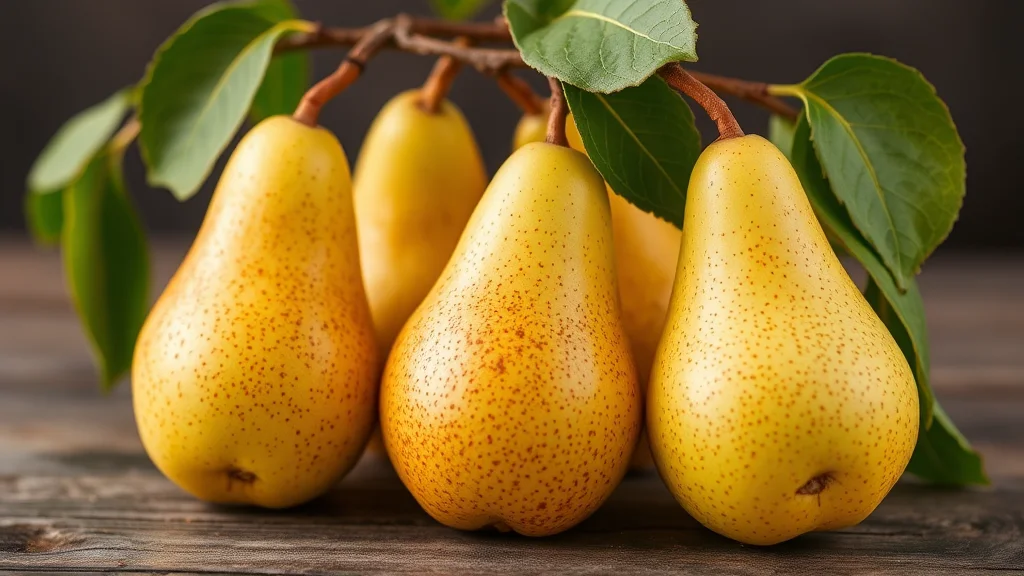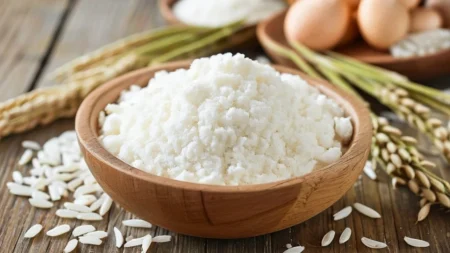Pears: A Juicy and Nutrient-Packed Fruit with Numerous Health Benefits
Key Takeaways:
- Pears are rich in fiber, vitamin C, and antioxidants.
- They support digestive health, boost the immune system, and may lower the risk of chronic diseases.
- Pears come in various types, each offering a unique flavor and texture, making them a versatile fruit in both raw and cooked forms.

Nutritional Profile of Pears
Pears are a delicious and nutritious fruit that can be enjoyed year-round. Below is the nutritional breakdown of a medium-sized pear (about 178 grams):
| Nutrient | Amount |
|---|---|
| Calories | 101 kcal |
| Protein | 0.6 grams |
| Total Fat | 0.3 grams |
| Carbohydrates | 27 grams |
| Dietary Fiber | 6 grams (24% DV) |
| Vitamin C | 7.65 mg (13% DV) |
| Potassium | 206 mg (6% DV) |
| Vitamin K | 7.8 mcg (10% DV) |
Rich in Fiber and Vitamin C
Pears are an excellent source of dietary fiber, particularly soluble fiber, which aids in digestion and promotes feelings of fullness. They are also a good source of vitamin C, which is vital for immune function, skin health, and tissue repair.
Health Benefits of Pears
1. Supports Digestive Health
Pears are high in dietary fiber, which is crucial for maintaining a healthy digestive system. The fiber in pears helps prevent constipation by promoting regular bowel movements. It also feeds beneficial gut bacteria, supporting overall gut health.
2. Boosts the Immune System
Thanks to their high vitamin C content, pears help strengthen the immune system. Vitamin C acts as an antioxidant, protecting the body from harmful free radicals and enhancing the body’s ability to fight off infections.
3. May Reduce the Risk of Chronic Diseases
Pears are loaded with antioxidants, including flavonoids and vitamin C, which help reduce inflammation and may lower the risk of chronic diseases such as heart disease and diabetes. The fiber in pears also plays a role in regulating blood sugar levels and improving cholesterol profiles.
Types of Pears
There are several different varieties of pears, each with its own distinct taste and texture. Here are the most common types:
| Type | Description |
|---|---|
| Bartlett Pears | Juicy and sweet, great for eating raw or canning. |
| Anjou Pears | Mild-flavored with a firm texture, ideal for baking. |
| Bosc Pears | Crisp and firm, perfect for cooking and poaching. |
| Comice Pears | Extremely sweet and soft, often eaten raw. |
| Seckel Pears | Small and very sweet, often used in desserts. |
Bartlett Pears
Bartlett pears are one of the most common varieties. They have a smooth, juicy texture and a sweet, slightly tart flavor. They are great for eating fresh or using in salads and desserts.
Anjou Pears
Anjou pears have a mild flavor and firm texture, making them perfect for cooking and baking. They hold their shape well and can be used in both sweet and savory dishes.
How to Incorporate Pears into Your Diet
Pears are versatile and can be enjoyed in a variety of ways. Here are some creative ideas to include pears in your meals:
1. Raw Pears as a Snack
Enjoy fresh pears as a healthy snack on their own or pair them with cheese, nuts, or yogurt for added flavor and nutrition. They make for a quick, portable snack and are easy to take on the go.
2. Pears in Salads
Add sliced pears to green salads for a burst of sweetness. Pears pair well with leafy greens, nuts, cheeses, and vinaigrettes, making them a perfect ingredient for a well-balanced salad.
3. Baked or Poached Pears
For a warm, comforting dessert, bake or poach pears with a sprinkle of cinnamon and honey. This brings out their natural sweetness and creates a delicious, low-calorie dessert option.
Pears for Weight Management
Due to their high fiber content, pears are an excellent choice for those looking to manage their weight. The fiber in pears helps promote satiety, reducing overall calorie intake by keeping you feeling full for longer. Additionally, pears are low in calories and fat, making them a guilt-free snack or addition to meals.
Cooking with Pears
Pears can be used in a variety of dishes, from breakfast to dinner and dessert. Here are some ways to incorporate pears into your cooking:
| Dish | How to Use Pears |
|---|---|
| Smoothies | Blend pears with greens, yogurt, and other fruits. |
| Oatmeal | Add diced pears and cinnamon to your morning oats. |
| Roasts | Pair roasted pears with meats like pork or chicken. |
| Desserts | Use pears in pies, tarts, or crumbles. |
Pear Smoothies
Blend pears into your morning smoothie for a sweet and refreshing flavor. Combine pears with ingredients like spinach, bananas, and almond milk for a nutrient-packed breakfast option.
Oatmeal with Pears
Top your oatmeal with fresh or cooked pears, along with a sprinkle of cinnamon and a drizzle of honey. The natural sweetness of pears complements the warm, hearty oats perfectly.
Conclusion
Pears are a nutritious, fiber-rich fruit that offers a range of health benefits, from supporting digestion to boosting the immune system. With their variety of flavors and textures, pears are a versatile fruit that can be enjoyed in many different ways. Whether eaten fresh, baked, or added to dishes, pears are a delicious and healthy addition to any diet.
FAQ
Q: Are pears good for digestion?
A: Yes, pears are high in dietary fiber, which supports digestive health by promoting regular bowel movements and feeding beneficial gut bacteria.
Q: What is the best way to store pears?
A: Store pears at room temperature until they ripen. Once ripe, they can be stored in the refrigerator for a few more days to prolong freshness.
Q: Can pears help with weight loss?
A: Pears are low in calories and high in fiber, making them a great addition to a weight management plan as they promote fullness and reduce overall calorie intake.
Q: Are pears safe for people with diabetes?
A: Pears have a low glycemic index and their high fiber content helps regulate blood sugar levels, making them a good fruit choice for people with diabetes.










